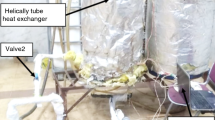Abstract—
Development of quick and versatile simulation packages to investigate time dependent heat transfer phenomena in nuclear reactors or steam generators is an ongoing research interest. The work presented herein is an alternative attempt to address this issue employing a single heated channel framework. A homogenous equivalent mixture is assumed for the two phase flow inside the channel. The sectionalized compressible formalism is further refined and the resultant PDEs are cast into a nodalized layout employing the method of lines as a reduction scheme. Simulation results are presented for the transient heat transfer inside a coolant channel of a nuclear reactor core wherein the incumbent heat flux is affected through an inherent thermo-neutronic feedback mechanism. The overall model reduction strategy likewise provides a suitable platform for the purpose of stability analysis or control synthesis practices.




Similar content being viewed by others
REFERENCES
S. Bendedk, “A computer code for nuclear reactor core thermal transients,” Kernenergie 21, 29–34 (1978).
W. L. Woodruff, “A kinetics and thermal hydraulics capability for the thermal analysis of research reactors,” Nucl. Technol. 64 (2), 196–206 (1984). https://doi.org/10.13182/NT84-A33342
N. Khola and M. Pandey, “Numerical computation of one-dimensional unsteady two-phase flow using HEM model and IAPWS IF-97 equations of state,” in Proc. 21st Int. Conf. on Nuclear Engineering (Chengdu, China, July 29– August 2, 2013), Vol. 4: Thermal Hydraulics, p. ICONE21-16611 (ASME, 2013). https://doi.org/10.1115/ICONE21-16611
S. H. Sangestani, M. Rahgoshay, N. Vosoughi, and M. A. Allaf, “Study of fast transient pressure drop in VVER‑1000 nuclear reactor using acoustic phenomenon,” Sci. Technol. Nucl. Install. 2018, 7862847 (2018). https://doi.org/10.1155/2018/7862847
J. Al Zain, O. El Hajjaji, T. El Bardouni, and Y. Boulaich, “Coupling of neutronics and thermal-hydraulic codes for simulation of the MNSR reactor,” Nucl. Sci. Eng. 193 (11), 1276–1289 (2019). https://doi.org/10.1080/00295639.2019.1622927
J. E. Meyer, “Hydrodynamic models for the treatment of reactor thermal transients,” Nucl. Sci. Eng. 10 (3), 269–277 (1961). https://doi.org/10.13182/NSE61-A25970
M. Lee and M. S. Kazimi, Transient Response of a Single Heated Channel (MIT, Cambridge, MA, 1984).
J. H. Mahaffy, “Numerics of codes: stability, diffusion and convergence,” Nucl. Eng. Des. 145 (1–2), 131–145 (1993). https://doi.org/10.1016/0029-5493(93)90063-F
H.-X. Li and C. Qi, “Modeling of distributed parameter systems for applications—A synthesized review from time-space separation,” J. Process Control 20 (8), 891–901 (2010). https://doi.org/10.1016/j.jprocont.2010.06.016
F. Shakeri and M. Dehghan, “The method of lines for solution of the one-dimensional wave equation subject to an integral conservation condition,” Comput. Math. Appl. 56 (9), 2175–2188 (2008). https://doi.org/10.1016/j.camwa.2008.03.055
M. N. Mikhail, “On the validity and stability of the method of lines for the solution of partial differential equations,” Appl. Math. Comput. 22 (2–3), 89–98 (1987). https://doi.org/10.1016/0096-3003(87)90038-5
M. Zarei, “On a reduced order modeling of the nuclear reactor dynamics,” Appl. Math. Comput. 393, 125819 (2021). https://doi.org/10.1016/j.amc.2020.125819
S. Paul and S. Singh, “Linear stability analysis of flow instabilities with a nodalized reduced order model in heated channel,” Int. J. Therm. Sci. 98, 312–331 (2015). https://doi.org/10.1016/j.ijthermalsci.2015.07.027
W. J. Garland and B. J. Hand, “Simple functions for the fast approximation of light water thermodynamic properties,” Nucl. Eng. Des. 113 (1), 21–34 (1989). https://doi.org/10.1016/0029-5493(89)90293-8
R. Ashino, M. Nagase, and R. Vaillancourt, “Behind and beyond the MATLAB ODE suite,” Comput. Math. Appl. 40 (4–5), 491–512 (2000). https://doi.org/10.1016/S0898-1221(00)00175-9
Author information
Authors and Affiliations
Corresponding author
Ethics declarations
The author declares that he has no conflicts of interest.
Rights and permissions
About this article
Cite this article
Zarei, M. An Alternative Formalism for the Single-Heated Channel Numerical Analysis. Math Models Comput Simul 14, 1044–1050 (2022). https://doi.org/10.1134/S2070048222060187
Received:
Revised:
Accepted:
Published:
Issue Date:
DOI: https://doi.org/10.1134/S2070048222060187




